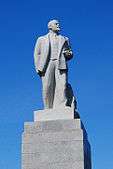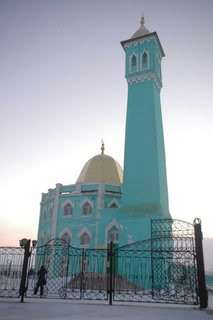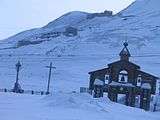Norilsk
| Norilsk (English) Норильск (Russian) | |
|---|---|
| - City[1] - | |
 The first house built in Norilsk, in 1921 | |
.svg.png) Location of Krasnoyarsk Krai in Russia | |
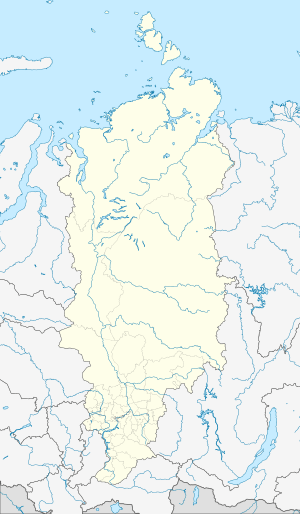 Norilsk | |
|
| |
.png) |
|
|
| |
| Administrative status (as of January 2014) | |
| Country | Russia |
| Federal subject | Krasnoyarsk Krai[1] |
| Administratively subordinated to | krai city of Norilsk[1] |
| Administrative center of | krai city of Norilsk[1] |
| Municipal status (as of December 2004) | |
| Urban okrug | Norilsk Urban Okrug[2] |
| Administrative center of | Norilsk Urban Okrug[2] |
| Statistics | |
| Population (2010 Census) | 175,365 inhabitants[3] |
| - Rank in 2010 | 102nd |
| Time zone | KRAT (UTC+07:00)[4] |
| Founded | 1935[5] |
| City status since | 1953[5] |
| Postal code(s)[6] | 663300-663341 |
| Dialing code(s) | +7 3919[7] |
|
| |
| Norilsk on Wikimedia Commons | |
Norilsk (Russian: Норильск; IPA: [nɐˈrʲilʲsk]) is an industrial city in Krasnoyarsk Krai, Russia, located above the Arctic Circle, east of the Yenisei River and south of the western Taymyr Peninsula. It has a permanent population of 175,000. With temporary inhabitants included, its population reaches 220,000.
Norilsk was closed in November 2001 to all non-Russians, except for Belarusians.[8]
It is the world's northernmost city with more than 100,000 inhabitants and the second largest city (after Murmansk) inside the Arctic Circle. Norilsk, Yakutsk, and Vorkuta are the only large cities in the continuous permafrost zone.
History
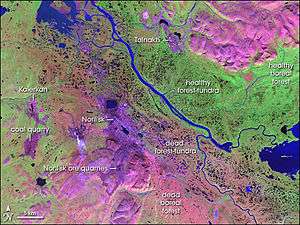
Norilsk was founded at the end of the 1920s, but the official date of founding is traditionally 1935, when Norilsk was expanded as a settlement for the Norilsk mining-metallurgic complex and became the center of the Norillag system of GULAG labor camps. It was granted urban-type settlement status in 1939 and town status in 1953.[9]
Norilsk is located between the West Siberian Plain and Central Siberian Plateau at the foot of the 1,700-meter (5,600 ft) high Putoran Mountains, on some of the largest nickel deposits on Earth. Consequently, mining and smelting ore are the major industries. Norilsk is the center of a region where nickel, copper, cobalt, platinum, palladium and coal are mined. Mineral deposits in the Siberian Craton had been known for two centuries before Norilsk was founded, but mining began only in 1939, when the buried portions of the Norilsk-Talnakh intrusions were found beneath mountainous terrain.
Talnakh is the major mine/enrichment site now from where an enriched ore emulsion is pumped to Norilsk metallurgy plants.
To support the new city, a railway to the port of Dudinka on the Yenisei River was established, first as a narrow-gauge line (winter 1935–36), later as 1,520 mm (4 ft 11 27⁄32 in) Russian standard gauge line (completed in the early 1950s).[10] From Dudinka, enriched nickel and copper are transported to Murmansk by sea and, then, to the Monchegorsk enrichment and smelting plant on the Kola Peninsula, while more precious content goes up the river to Krasnoyarsk. This transportation only takes place during the summer. The port of Dudinka is closed and dismantled during spring's ice barrier floods of up to 20 meters (66 ft) in late May (a typical spring occurrence on all Siberian rivers).[11]
In the early 1950s, another railway was under construction from the European coal city Vorkuta via the Salekhard/Ob River, and Norilsk got a spacious railway station built in the expectation of train service to Moscow,[10] but construction stopped after Joseph Stalin died.
According to the archives of Norillag, 16,806 prisoners died in Norilsk under the conditions of forced labor, starvation and intense cold during the existence of the camp (1935–1956).[12] Fatalities were especially high during the war years of 1942–1944 when food supplies were particularly scarce. Prisoners organised the nonviolent Norilsk uprising in 1953. Unknown but significant numbers of prisoners continued to serve and die in the mines until around 1979. Norilsk-Talknakh continues to be a dangerous mine to work in: according to the mining company, there were 2.4 accidents per thousand workers in 2005.[13] Since the early 2000s the city has been rebuilding itself and reshaping its image. Bars on the top floors of apartments are appearing and buildings are getting renovated.
Administrative and municipal status
Within the framework of administrative divisions, it is, together with the urban-type settlement of Snezhnogorsk, incorporated as the krai city of Norilsk—an administrative unit with the status equal to that of the districts.[1] As a municipal division, the krai city of Norilsk is incorporated as Norilsk Urban Okrug.[2]
Demographics
Religion
There is a mosque in Norilsk. Built in 1998 belonging to the local Tatar community, it is considered to be the northernmost Muslim prayer house in the world.[14] There is also a Russian Orthodox cathedral, several Russian Orthodox churches and a Ukrainian Orthodox church.
Population
175,365 (2010 Census)[3]:[15] after the fall of the USSR, its population went down by 40,000, but this was offset by the subsequent merger of the towns of Kayerkan and Talnakh into Norilsk, maintaining a permanent population of 175,000. Including temporary residents, the population reaches 220,000 people. Around 80% of the permanent population are thought to be Russified Ukrainians.
| 1939 | 1959 | 1962 | 1967 | 1970 | 1973 | 1976 |
|---|---|---|---|---|---|---|
| 14,000 | 118,000 | 117,000 | 129,000 | 135,000 | 150,000 | 167,000 |
| 1979 | 1982 | 1989 | 1992 | 1998 | 2002 | 2005 |
| 180,400 | 183,000 | 174,673 | 165,400 | 151,200 | 134,832 | 131,900 |
Geography, climate, and natural environment

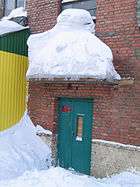
Norilsk is the world's northernmost city with more than 100,000 inhabitants and the second largest city (after Murmansk) inside the Arctic Circle. Norilsk, Yakutsk and Vorkuta are the only large cities in the continuous permafrost zone. It lies between Taymyrsky Dolgano-Nenetsky District to the north, and Turukhansky District to the south. Norilsk has an extremely harsh subarctic climate (Köppen Dfc), and is covered with snow for about 250–270 days a year, with snow storms for about 110–130 days. The "midnight sun" is above the horizon from 21 May to 24 July, and the period when the sun does not rise, polar night, is from approximately 30 November to 13 January. Temperatures can sometimes rise above 25 °C (77 °F) in July.
Much of the surrounding areas are naturally treeless tundra. Only a few trees exist in Norilsk.
| Climate data for Norilsk | |||||||||||||
|---|---|---|---|---|---|---|---|---|---|---|---|---|---|
| Month | Jan | Feb | Mar | Apr | May | Jun | Jul | Aug | Sep | Oct | Nov | Dec | Year |
| Record high °C (°F) | −3.0 (26.6) |
−2.0 (28.4) |
7.4 (45.3) |
10.5 (50.9) |
22.8 (73) |
30.4 (86.7) |
32.0 (89.6) |
28.7 (83.7) |
18.6 (65.5) |
9.6 (49.3) |
3.1 (37.6) |
−1.0 (30.2) |
32 (89.6) |
| Average high °C (°F) | −23.9 (−11) |
−24.2 (−11.6) |
−18.8 (−1.8) |
−10.0 (14) |
−1.7 (28.9) |
10.4 (50.7) |
18.2 (64.8) |
15.0 (59) |
6.9 (44.4) |
−6.7 (19.9) |
−16.9 (1.6) |
−21.6 (−6.9) |
−6.11 (21) |
| Daily mean °C (°F) | −26.9 (−16.4) |
−27.2 (−17) |
−21.9 (−7.4) |
−13.9 (7) |
−4.8 (23.4) |
7.0 (44.6) |
14.3 (57.7) |
11.4 (52.5) |
4.0 (39.2) |
−9.5 (14.9) |
−20.2 (−4.4) |
−25.1 (−13.2) |
−9.4 (15.08) |
| Average low °C (°F) | −30.9 (−23.6) |
−31.5 (−24.7) |
−26.9 (−16.4) |
−18.5 (−1.3) |
−8.4 (16.9) |
3.2 (37.8) |
10.0 (50) |
7.6 (45.7) |
1.2 (34.2) |
−12.5 (9.5) |
−23.9 (−11) |
−28.9 (−20) |
−13.29 (8.09) |
| Record low °C (°F) | −53.1 (−63.6) |
−52.0 (−61.6) |
−46.1 (−51) |
−38.7 (−37.7) |
−26.8 (−16.2) |
−9.8 (14.4) |
0.4 (32.7) |
−1.0 (30.2) |
−14.0 (6.8) |
−36.0 (−32.8) |
−43.1 (−45.6) |
−51.0 (−59.8) |
−53.1 (−63.6) |
| Average precipitation mm (inches) | 17.6 (0.693) |
16.1 (0.634) |
28.4 (1.118) |
21.1 (0.831) |
24.0 (0.945) |
34.4 (1.354) |
32.4 (1.276) |
52.2 (2.055) |
26.0 (1.024) |
35.9 (1.413) |
30.8 (1.213) |
22.1 (0.87) |
341 (13.426) |
| Source #1: Weatherbase, except for the July record high | |||||||||||||
| Source #2: July record high: Official website of Norilsk. В Норильске самый жаркий июль за всю историю метеонаблюдений (Russian); The Siberian Times. Norilsk breaks records for Arctic heat in a new sign of changing weather patterns | |||||||||||||
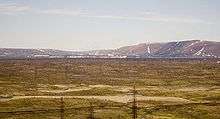
Pollution
Nickel ore is smelted on site at Norilsk. The smelting is directly responsible for severe pollution, generally acid rain and smog. By some estimates, 1 percent of global emissions of sulfur dioxide comes from Norilsk's nickel mines.[16] Heavy metal pollution near Norilsk is so severe that mining the surface soil is now economically feasible due to the soil acquiring such high concentrations of platinum and palladium.[17]
The Blacksmith Institute included Norilsk in its 2007 list of the ten most polluted places on Earth.[18] The list cites air pollution by particulates (including radioisotopes strontium-90, and caesium-137 and metals nickel, copper, cobalt, lead and selenium) and by gases (such as nitrogen and carbon oxides, sulfur dioxide, phenols and hydrogen sulfide). The Institute estimates four million tons of cadmium, copper, lead, nickel, arsenic, selenium and zinc are released into the air every year.[19]
The Russian Federal State Statistics Service named Norilsk the most polluted city in Russia. In 2010, Norilsk produced 1.924 million tons of carbon pollutants, nearly six times more than the 333 thousand tons generated by Russia's second most polluted city, Cherepovets.[20]
According to an April 2007 BBC News report,[21] Norilsk Nickel accepted responsibility for what had happened to the forests, and insisted they were taking action to cut the pollution. For the period up to 2015–2020 the company expects to reduce sulfur dioxide emissions by approximately two-thirds, but claims it is hard to guarantee this pace of reduction because they are still developing the technology.
In September 2016, images surfaced on social media of the nearby Daldykan River which had been turned red. Russia's Environment Ministry issued a statement claiming that preliminary evidence pointed towards wastewater pipes from a nearby smelting plant owned by Norilsk Nickel.[22]
Norilsk-Talnakh nickel deposits

The nickel deposits of Norilsk-Talnakh are the largest known nickel-copper-palladium deposits in the world. The deposit was formed 250 million years ago during the eruption of the Siberian Traps igneous province (STIP). The STIP erupted over one million cubic kilometers of lava, a large portion of it through a series of flat-lying lava conduits below Norilsk and the Talnakh Mountains.
The ore was formed when the erupting magma became saturated in sulfur, forming globules of pentlandite, chalcopyrite, and other sulfides. These sulfides were then "washed" by the continuing torrent of erupting magma, and upgraded their tenor with nickel, copper, platinum and palladium .
The current resource known for these mineralized intrusion exceeds 1.8 billion tons.[23] MMC Norilsk Nickel, headquartered in Moscow, is the principal mining operator in Norilsk-Talnakh. The ore is mined underground via several shafts, and a decline. The ore deposits are currently being extracted at more than 1,200 m (3,900 ft) below ground and drilled from the surface. Nickel production for 2008 amounted to 299.7 thousand metric tonnes. Copper production for 2008 amounted to 419 thousand metric tonnes.
The deposits are being explored by a Russian government-controlled company. The company is known to be using electromagnetic field geophysics, with loops on surface which are over 1,000 m (3,300 ft) on a side. They are conclusively able to image the conductive nickel ore at depths in excess of 1,800 m (5,900 ft).
Economy
MMC Norilsk Nickel, a mining company, is the principal employer in the Norilsk area.[18]
The city is served by Norilsk Alykel Airport and Norilsk Valek Airfield. There is a freight-only railway, the Norilsk railway between Norilsk and the port of Dudinka. There is a road network around Norilsk (such as the A-382 which links to Dudinka and Norilsk Alykel Airport), but no road or railway to the main cities of Russia. Freight transport is by boat on the Arctic Ocean or on the Yenisei River.
Culture
Among its cultural highlights, Norilsk boasts a history museum and an art gallery,[24] the Norilsk Polar Drama Theater,[25] a zoo,[26] a cultural center,[27] a sports and entertainment complex and arena,[28] many monuments and historical buildings[29] and other attractions.
|
Twin towns and sister cities
Norilsk is twinned with:
 Minusinsk, Russia
Minusinsk, Russia
Notable people
- Andrey Bartenev, artist[30]
- Vladimir Bure, swimmer
- Natalia Yurchenko, gymnast
- Walter Ciszek, Jesuit missionary priest and political prisoner
- Dmitri Torbinski, association football player
- Nadezhda Tolokonnikova, Russian political activist and member of the punk band Pussy Riot
References
Notes
- 1 2 3 4 5 Law #10-4765
- 1 2 3 Law #12-2697
- 1 2 Russian Federal State Statistics Service (2011). "Всероссийская перепись населения 2010 года. Том 1" [2010 All-Russian Population Census, vol. 1]. Всероссийская перепись населения 2010 года (2010 All-Russia Population Census) (in Russian). Federal State Statistics Service. Retrieved June 29, 2012.
- ↑ Правительство Российской Федерации. Федеральный закон №107-ФЗ от 3 июня 2011 г. «Об исчислении времени», в ред. Федерального закона №271-ФЗ от 03 июля 2016 г. «О внесении изменений в Федеральный закон "Об исчислении времени"». Вступил в силу по истечении шестидесяти дней после дня официального опубликования (6 августа 2011 г.). Опубликован: "Российская газета", №120, 6 июня 2011 г. (Government of the Russian Federation. Federal Law #107-FZ of June 31, 2011 On Calculating Time, as amended by the Federal Law #271-FZ of July 03, 2016 On Amending Federal Law "On Calculating Time". Effective as of after sixty days following the day of the official publication.).
- 1 2 Michail V. Kozlov; Elena Zvereva; Vitali Zverev (28 July 2009). Impacts of Point Polluters on Terrestrial Biota: Comparative analysis of 18 contaminated areas. Springer Science & Business Media. p. 63. ISBN 978-90-481-2467-1.
- ↑ Почта России. Информационно-вычислительный центр ОАСУ РПО. (Russian Post). Поиск объектов почтовой связи (Postal Objects Search) (Russian)
- ↑ "телефонных кодов" (in Russian). Retrieved 7 February 2016.
- ↑ "Russia Closes City to Foreigners". WorldNetDaily. November 28, 2001. Retrieved 13 January 2015.
- ↑ "Life behind closed doors in the Arctic is.....fun!".
- 1 2 По рельсам истории(Russian) ("Rolling on the rails of history"), Zapolyarnaya Pravda, No. 109 (July 28, 2007)
- ↑ "Northern Sea Route Information Office". Retrieved 8 February 2016.
- ↑ "Люди Норильлага" (in Russian).
- ↑ "Norilsk – Mining Hell". Retrieved 8 February 2016.
- ↑ Paxton, Robin (2007-05-15). "Arctic mosque stays open but Muslim numbers shrink". Reuters. Retrieved 2015-02-28.
- ↑ The large population increase between the 2002 and the 2010 Censuses is due to the merger of the towns of Kayerkan and Talnakh into Norilsk in December 2004
- ↑ "Norilsk, Siberia". NASA. Retrieved 8 February 2016.
- ↑ Kramer, Andrew E. (July 12, 2007). "For One Business, Polluted Clouds Have Silvery Linings". The New York Times. Retrieved July 12, 2007.
- 1 2 "World's Worst Polluted Places 2007". The Blacksmith Institute. September 2007. Retrieved August 10, 2010.
- ↑ "10 Places in Most Need of an Environmental Cleanup". Retrieved 8 February 2016.
- ↑ "City of Norilsk Still Tops Pollution List". Moscow Times. June 24, 2011. Retrieved November 17, 2013.
- ↑ "Toxic truth of secretive Siberian city". BBC News. April 5, 2007. Retrieved September 14, 2007.
- ↑ Reevell, Patrick (September 7, 2016). "River in Russia Mysteriously Turns Blood Red". Retrieved September 8, 2016 – via ABC News.
- ↑ "Mineral Reserves and Resources Statement". MMC Norilsk Nickel. November 3, 2008.
- ↑ "Museums in Norilsk". Trip Advisor. Retrieved March 26, 2015.
- ↑ "Norilsk Polar Drama Theater". Trip Advisor. Retrieved March 26, 2015.
- ↑ "Norilsk Zoos & Aquariums". Trip Advisor. Retrieved March 26, 2015.
- ↑ "Norilsk Town Cultural Center". Trip Advisor. Retrieved March 26, 2015.
- ↑ "Sport Entertainment Complex Arena". Trip Advisor. Retrieved March 26, 2015.
- ↑ "Norilsk Sights". Trip Advisor. Retrieved March 26, 2015.
- ↑ Waldemar Januszczak (January 20, 2008). "Darker than it looks". Times Online. London. Retrieved January 26, 2008. (subscription required (help)).
Sources
- Законодательное собрание Красноярского края. Закон №10-4765 от 10 июня 2010 г. «О перечне административно-территориальных единиц и территориальных единиц Красноярского края», в ред. Закона №7-3007 от 16 декабря 2014 г. «Об изменении административно-территориального устройства Большеулуйского района и о внесении изменений в Закон края "О перечне административно-территориальных единиц и территориальных единиц Красноярского края"». Вступил в силу 1 июля 2010 г. Опубликован: "Ведомости высших органов государственной власти Красноярского края", №33(404), 5 июля 2010 г. (Legislative Assembly of Krasnoyarsk Krai. Law #10-4765 of June 10, 2010 On the Registry of the Administrative-Territorial Units and the Territorial Units of Krasnoyarsk Krai, as amended by the Law #7-3007 of December 16, 2014 On Changing the Administrative-Territorial Structure of Bolsheuluysky District and on Amending the Krai Law "On the Registry of the Administrative-Territorial Units and the Territorial Units of Krasnoyarsk Krai". Effective as of July 1, 2010.).
- Законодательное собрание Красноярского края. Закон №12-2697 от 10 декабря 2004 г. «О наделении муниципального образования город Норильск статусом городского округа», в ред. Закона №5-1826 от 21 ноября 2013 г. «О внесении изменений в Законы края об установлении границ и наделении соответствующим статусом муниципальных образований Красноярского края». Вступил в силу через десять дней после официального опубликования. Опубликован: "Ведомости высших органов государственной власти Красноярского края", №34, 19 декабря 2004 г. (Legislative Assembly of Krasnoyarsk Krai. Law #12-2697 of December 10, 2004 On Granting Urban Okrug Status to the Municipal Formation of the City of Norilsk, as amended by the Law #5-1826 of November 21, 2013 On Amending the Krai Laws on Establishing the Borders and Granting an Appropriate Status to the Municipal Formations of Krasnoyarsk Krai. Effective as of the day ten days after the official publication.).
- "Norilskaya golgofa"(Russian) "Memorial", regional Branch "Siberia", publisher: "Klaretianum", Krasnoyarsk, 2002
External links
| Wikimedia Commons has media related to Norilsk. |
| Wikivoyage has a travel guide for Norilsk. |

